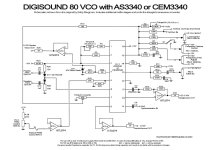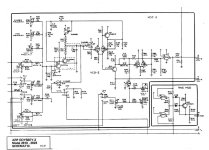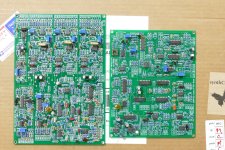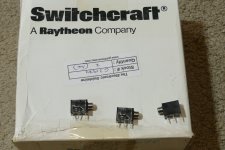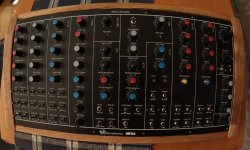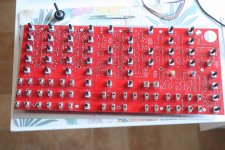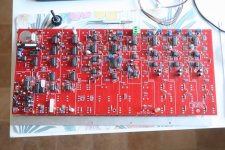The thing that you should understand about Serge is that a Serge module can be a more fundamental unit than the average Eurorack module.I dunno, the system looks very Serge inspired to me, think bananas are the way to go. Haven’t looked at the voltages though, maybe they are the same as Euro?
Eurorack and compatible semi-modular are the obvious and popular thing to do but I am inexplicably drawn towards Serge and other banana based patching systems.
For beginning synthesis, I'd say go with semi-modular first. It is actually nearly modular, the only difference being that there's a pre-patched signal path to start with. If you add a patch cord between two points, you disconnect the internal patching at these two points and route the signal in this new cable.
Patch recall for Eurorack or other modular isn't strictly a necessary thing. If you want that kind of thing for cheap, a mono synth with a good modulation matrix and patch recall can do the trick.
An easy way to do patch recall is to get the whole modular inside the computer, e.g. VCV Rack allows you to do that.
Yes, I was replying to your post on it. I did find the reduced prices around Black Friday, considered it briefly, but there seems to be people not gelling with the UI and workflow. I may still get one someday, we'll see.OK, I couldn't say no. During checkout Honey threw some coupons at Reverb and got another $10 off for a price of $119 with free shipping, but sales tax brought it up to $127. Now we will see if I can hook two SQ-64's together with a Keystep and a NDLR. Looks like I'll need a few more MIDI cables and TRS adapters.
Yeah, seems like you need to be really interested in analog synthesis to enjoy a Serge system. A lot of eurorack seems to be prepackaged functions whereas in Serge you are expected to build that stuff from scratch. There are official Serge eurorack modules but they lack the bananas and better ergonomics of the 4u systems.The thing that you should understand about Serge is that a Serge module can be a more fundamental unit than the average Eurorack module.
For beginning synthesis, I'd say go with semi-modular first. It is actually nearly modular, the only difference being that there's a pre-patched signal path to start with. If you add a patch cord between two points, you disconnect the internal patching at these two points and route the signal in this new cable.
Patch recall for Eurorack or other modular isn't strictly a necessary thing. If you want that kind of thing for cheap, a mono synth with a good modulation matrix and patch recall can do the trick.
An easy way to do patch recall is to get the whole modular inside the computer, e.g. VCV Rack allows you to do that.
Like I said before, I probably will go with a semi modular system to start. The eurorack world has an astonishing amount of variety. I’ve been messing with VCV rack and while it is interesting I don’t find it fun. Want to get off the computer.
VCV Rack and Cherry Audio's Voltage Modular are good for testing new "can I do that" ideas without spending any money or possibly blowing stuff up.
Eurorack modular seems to be the most popular, saves space and power, and probably gives the most choices of "out there" oddball modules. Eurorack modules seem to cost a bit less than a similar module in a different format. Some of the front panels can be crowded for clumsy fat fingered people like me.
If Eurorack is in your future some of the Behringer clone synths will drop into your rack and provide a full synth for a starting point. Their "D" is a Minimoog clone with MIDI in (which can be ignored) and 13 control jacks for interfacing with other Eurorack modules. The CV jacks on the D seem to play well with most other Eurorack stuff. The Neutron is a unique Behringer design using reissues of the old CEM 3300 series chips. It also has a large patchbay with 32 inputs and 24 outputs routed to the important points inside the synth, which is pre routed if nothing is plugged in. It also plays well with other eurorack stuff. The Behringer K2 is a Korg MS-20 clone which is useful as an extra synth voice. It also has 34 I/O jacks, but most of the C/V's are -5 to +5 volts, which don't always work well with other modules.
The Analog synth world seems to have settled on Moog's old 1 volt per octave standard, which is good, but there is no standard as to what voltage is octave 1, and what voltage range is supported at the input or output of any given module. There are 0 to 5 volt devices (common) which allow for only a 5 octave range. There are also 0 to 10 or 12 volts, and -5 to +5, +10, or +12 volts and even -10 to +10 volt devices. The Behringer K2 mixes 0 to 5 and -5 to +5 in the same synth which requires some thinking before random plugging. A well designed module should be able to eat -12 to +12 volts as well as a dead short on its inputs and outputs to accommodate those who will try anything. Watch some Youtube "synth experts" play with patch cables and you will see why.
The chart on this page describes the size and power requirements for all the popular modular formants, but I can't find the chart of the I/O voltages.
https://shop.synthesizers.com/pages/form-factors
Eurorack modular seems to be the most popular, saves space and power, and probably gives the most choices of "out there" oddball modules. Eurorack modules seem to cost a bit less than a similar module in a different format. Some of the front panels can be crowded for clumsy fat fingered people like me.
If Eurorack is in your future some of the Behringer clone synths will drop into your rack and provide a full synth for a starting point. Their "D" is a Minimoog clone with MIDI in (which can be ignored) and 13 control jacks for interfacing with other Eurorack modules. The CV jacks on the D seem to play well with most other Eurorack stuff. The Neutron is a unique Behringer design using reissues of the old CEM 3300 series chips. It also has a large patchbay with 32 inputs and 24 outputs routed to the important points inside the synth, which is pre routed if nothing is plugged in. It also plays well with other eurorack stuff. The Behringer K2 is a Korg MS-20 clone which is useful as an extra synth voice. It also has 34 I/O jacks, but most of the C/V's are -5 to +5 volts, which don't always work well with other modules.
The Analog synth world seems to have settled on Moog's old 1 volt per octave standard, which is good, but there is no standard as to what voltage is octave 1, and what voltage range is supported at the input or output of any given module. There are 0 to 5 volt devices (common) which allow for only a 5 octave range. There are also 0 to 10 or 12 volts, and -5 to +5, +10, or +12 volts and even -10 to +10 volt devices. The Behringer K2 mixes 0 to 5 and -5 to +5 in the same synth which requires some thinking before random plugging. A well designed module should be able to eat -12 to +12 volts as well as a dead short on its inputs and outputs to accommodate those who will try anything. Watch some Youtube "synth experts" play with patch cables and you will see why.
The chart on this page describes the size and power requirements for all the popular modular formants, but I can't find the chart of the I/O voltages.
https://shop.synthesizers.com/pages/form-factors
Synthcube now sells reissues of the Ultimate and Ultimate expander panels. At least on these panels the holes are too large for any of the mini jacks that I have, so a washer or other ugly spacer will be needed. The supply voltages for the Ultimate and expander is +/- 12 volts which is compatible with Eurorack. Some outputs are capable of swinging nearly rail to rail which may not work well with some eurorack inputs. My Ultimate and expander boards are populated but I have not yet figured out what case and jack scheme I will use. I'm going to need a bigger space if this synth stuff keeps growing.He points out that you could easily use mini jacks instead of bananas if you wanted to integrate it into a eurorack system. I dunno, the system looks very Serge inspired to me, think bananas are the way to go. Haven’t looked at the voltages though, maybe they are the same as Euro?
I appreciate the info. Been looking into synths for a bit. The current Behringer synths don’t have a lot of appeal but some of the announced ones do. The Proton is the next version of the Neutron and it looks good. In particular it looks like they have changed (or eliminated?) the flow of everything going through overdrive by default. The 15 looks good but while I don’t have any problem with Behringer cloning an old synth like the MiniMoog, cloning a current model feels a bit icky. The 15 and the Grandmother are almost completely the same.VCV Rack and Cherry Audio's Voltage Modular are good for testing new "can I do that" ideas without spending any money or possibly blowing stuff up.
Eurorack modular seems to be the most popular, saves space and power, and probably gives the most choices of "out there" oddball modules. Eurorack modules seem to cost a bit less than a similar module in a different format. Some of the front panels can be crowded for clumsy fat fingered people like me.
If Eurorack is in your future some of the Behringer clone synths will drop into your rack and provide a full synth for a starting point. Their "D" is a Minimoog clone with MIDI in (which can be ignored) and 13 control jacks for interfacing with other Eurorack modules. The CV jacks on the D seem to play well with most other Eurorack stuff. The Neutron is a unique Behringer design using reissues of the old CEM 3300 series chips. It also has a large patchbay with 32 inputs and 24 outputs routed to the important points inside the synth, which is pre routed if nothing is plugged in. It also plays well with other eurorack stuff. The Behringer K2 is a Korg MS-20 clone which is useful as an extra synth voice. It also has 34 I/O jacks, but most of the C/V's are -5 to +5 volts, which don't always work well with other modules.
The Analog synth world seems to have settled on Moog's old 1 volt per octave standard, which is good, but there is no standard as to what voltage is octave 1, and what voltage range is supported at the input or output of any given module. There are 0 to 5 volt devices (common) which allow for only a 5 octave range. There are also 0 to 10 or 12 volts, and -5 to +5, +10, or +12 volts and even -10 to +10 volt devices. The Behringer K2 mixes 0 to 5 and -5 to +5 in the same synth which requires some thinking before random plugging. A well designed module should be able to eat -12 to +12 volts as well as a dead short on its inputs and outputs to accommodate those who will try anything. Watch some Youtube "synth experts" play with patch cables and you will see why.
The chart on this page describes the size and power requirements for all the popular modular formants, but I can't find the chart of the I/O voltages.
https://shop.synthesizers.com/pages/form-factors
I really like the Pittsburgh Modular filter and so have been looking at both their East Beast and now the Taiga. The Beast is only $250 as is its West coast brother the West Pest and those are tempting. The Taiga is wild with three oscillators with a wave folder for each one plus that great filter. I’ve seen some crazy cross modulated patches on the Taiga. All of them can be dropped in a rack if wanted.
I’ve heard some Serge enthusiasts extoll the virtues of everything having the same voltage output. Euro rack really is all over the place and it’s something to look out for when mixing brands. There is something to be said for keeping everything the same just for consistency’s sake. I think Buchla has separate standards for audio and CV. The Buchla eurorack modules allow them to be interchanged like all the others do.
The Eurorack module's are mostly overpriced. The Behringer analog synths (modules) are good circuits , with cheap outsourced parts.
So , I think I can take my AS3340's (VCO - 1) , and make something better. Buffer everything with standardized +/- 5V. add the sine shaper...
A fully discrete VCO (below 2) is doable , but with the tempco and matching considerations.
Best to start with the VCOs , they are the "what you hear". Filters are almost as important....
OS
So , I think I can take my AS3340's (VCO - 1) , and make something better. Buffer everything with standardized +/- 5V. add the sine shaper...
A fully discrete VCO (below 2) is doable , but with the tempco and matching considerations.
Best to start with the VCOs , they are the "what you hear". Filters are almost as important....
OS
Attachments
The original MFOS (Music From Outer Space) synth stuff was an entry point for a lot of people. Ray's web site popped up in 2003 and grew larger every few months. All of his ideas were usually published online. He also had a YouTube channel. I had already been down the analog synth path mostly with stuff I wish that I had kept, like a 1st Gen ARP Odyssey, a pair of Univox branded Mini Korgs running from one keyboard and an Aries modular synth. I sold them all in the digital 80's and got a Korg DW8000.
By 2003 I had repossessed my daughter's JV1000 and bought a used JV880, both of which I still have. I never ventured down the MFOS path until about 2010 when I bought the PC board and front panel for the MFOS "Ultimate." I got the board quickly but the panel was on back order. I started populating the board, but never finished it. All of my DIY synth stuff got boxed up as I knew by 2011 that my career was on life support, and I would leave Florida when the end came. I wound up in West Virginia in 2014 and have not seen the box of DIY synth stuff since the move. While I was living in a temporary place without a lab, I bought another Ultimate board and an Ultimate Expander board from Synthcube who acquired the rights to all the MFOS stuff when Ray passed. The boards were fully populated during that time, then stored for the final move. Synthcube recreated the original front panels, so I got a set of them last year. Most of the pots and switches have been mounted, but neither the Ultimate or the Expander have been finished......
Ray created what is probably the simplest possible version of a "typical" Analog synth back in 2012, the Noise Toaster. It has the typical VCO, VCF and VCA albeit simplified and NOT compatible with the typical 1 volt per octave standard created by Moog years ago.
Synthcube is running a contest to feature the Noise Toaster. They offer gift certificates and other MFOS kits as prizes. I have been a Synthcube customer for many years, so I was notified by email yesterday. This contest has already been running for two days and I can find very little evidence that it exists on Synthcube's web site or anywhere else except for the Matrixsynth web site.
https://www.matrixsynth.com/2023/11/music-from-outer-space-and-synthcube.html
The rules that are posted in the link are not specific as to what is allowed, and what is not. I sent an email to Synthcube asking for some clarification, and a better definition of "What is a Noise Toaster?" Since the schematic is published and quite simple to duplicate (two LM324 opamps and an LM386 audio amp with speaker), and "no purchase is required" to enter the contest, could I DIY my own and what could I add or delete. I specifically asked if I could add an SBC like a Teensy for use as a sequencer or for other improvements and additions. Are additional controls for the sequencer and other additions allowed? I got an answer rather quickly......."In the spirit of DIY… it has to be recognizable from the base schematic at the core…. You may use, but don’t have to use , the main PCB or panel. Add-ons/mods encouraged." OK, I'm game.
Synthcube is running a 25% off almost everything sale through Monday 11/27 so my next thought is deciding whether spending $29 - 25% worth the time it would take me to breadboard the Toaster, remembering that this is possibly a "beauty contest." It looks like that I have most of the parts.....somewhere.
By 2003 I had repossessed my daughter's JV1000 and bought a used JV880, both of which I still have. I never ventured down the MFOS path until about 2010 when I bought the PC board and front panel for the MFOS "Ultimate." I got the board quickly but the panel was on back order. I started populating the board, but never finished it. All of my DIY synth stuff got boxed up as I knew by 2011 that my career was on life support, and I would leave Florida when the end came. I wound up in West Virginia in 2014 and have not seen the box of DIY synth stuff since the move. While I was living in a temporary place without a lab, I bought another Ultimate board and an Ultimate Expander board from Synthcube who acquired the rights to all the MFOS stuff when Ray passed. The boards were fully populated during that time, then stored for the final move. Synthcube recreated the original front panels, so I got a set of them last year. Most of the pots and switches have been mounted, but neither the Ultimate or the Expander have been finished......
Ray created what is probably the simplest possible version of a "typical" Analog synth back in 2012, the Noise Toaster. It has the typical VCO, VCF and VCA albeit simplified and NOT compatible with the typical 1 volt per octave standard created by Moog years ago.
Synthcube is running a contest to feature the Noise Toaster. They offer gift certificates and other MFOS kits as prizes. I have been a Synthcube customer for many years, so I was notified by email yesterday. This contest has already been running for two days and I can find very little evidence that it exists on Synthcube's web site or anywhere else except for the Matrixsynth web site.
https://www.matrixsynth.com/2023/11/music-from-outer-space-and-synthcube.html
The rules that are posted in the link are not specific as to what is allowed, and what is not. I sent an email to Synthcube asking for some clarification, and a better definition of "What is a Noise Toaster?" Since the schematic is published and quite simple to duplicate (two LM324 opamps and an LM386 audio amp with speaker), and "no purchase is required" to enter the contest, could I DIY my own and what could I add or delete. I specifically asked if I could add an SBC like a Teensy for use as a sequencer or for other improvements and additions. Are additional controls for the sequencer and other additions allowed? I got an answer rather quickly......."In the spirit of DIY… it has to be recognizable from the base schematic at the core…. You may use, but don’t have to use , the main PCB or panel. Add-ons/mods encouraged." OK, I'm game.
Synthcube is running a 25% off almost everything sale through Monday 11/27 so my next thought is deciding whether spending $29 - 25% worth the time it would take me to breadboard the Toaster, remembering that this is possibly a "beauty contest." It looks like that I have most of the parts.....somewhere.
I am "struggling" with my second Noise Toaster. The first one, seen below, was given to two of my grandkids and the second will go to a grandson. However I have been using a cheap Chinese box (with crappy plastic) so it doesn't look that nice really, but I hope the adding of a PT2399 echo module will sort of make things up a bit.
The only wish I have is that someone could remake the PCB to have the potentiometers and switches mounted on that board, thus eliminating all the wiring.

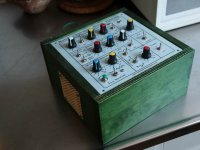
The only wish I have is that someone could remake the PCB to have the potentiometers and switches mounted on that board, thus eliminating all the wiring.


I agree with the point about the front panel wiring. That's the real reason that my Ultimate and Ultimate Expander remain unfinished. Everything else is done. My 71 year old fingers don't always go where I aim them which results in soldering my fingers almost as often as I complete a successful connection to a pot or switch. Some pots and switches can be wired before mounting, but some have a common ground or supply wire running throughout the panel. My attempt to prewire them left me with some pots that didn't fit (wire too short), so it all got tossed in a box about a year ago.
I have often made PC boards that do the pot wiring. This works and may be feasible for the Noise Toaster but the Ultimate would require a big board.
NOTE: If you have a board like the Progue Synth that has the electronics and pots on the same board, build it in this order.
Usually some or all of the small parts can be populated first. The Progue is mostly SMD, so it is best to do the SMD stuff first. Test fit all the pots and switches to make sure that they fit and are all the same height so that the front panel will fit properly. Some of the pots that I used on the Progue build were taller than the others, and the Ali Express switches that looked like clones of the Moog switches did not fit the board.
Put the all the pots in the board, but do not solder them. Place the panel onto all the pots and make sure everything fits, install a few of the pot nuts around the edges, then clamp or band the sandwich together, flip it over and solder each pot. Then install the remaining nuts. I learned this the hard way a long time ago.
I have often made PC boards that do the pot wiring. This works and may be feasible for the Noise Toaster but the Ultimate would require a big board.
NOTE: If you have a board like the Progue Synth that has the electronics and pots on the same board, build it in this order.
Usually some or all of the small parts can be populated first. The Progue is mostly SMD, so it is best to do the SMD stuff first. Test fit all the pots and switches to make sure that they fit and are all the same height so that the front panel will fit properly. Some of the pots that I used on the Progue build were taller than the others, and the Ali Express switches that looked like clones of the Moog switches did not fit the board.
Put the all the pots in the board, but do not solder them. Place the panel onto all the pots and make sure everything fits, install a few of the pot nuts around the edges, then clamp or band the sandwich together, flip it over and solder each pot. Then install the remaining nuts. I learned this the hard way a long time ago.
I had written a longer text when Fire-f***ing-fox decided to drop dead, but I wrote something about Ray Wilson being a great guy and looking at his creations it is clear he had a "crazy" brain and his moduls and projects are evidence that he acted on his own instincts and ideas. And maybe he was more into gettingthe schematics and ciruits to work than getting the modules made in a way to facilitate construction.
I have the Soundlab and Soundlab Mk2 and the latter has some 100+ wires. I am through with the VCOs. However these two synthesizers are great and a fine starting for anyone who wants to dive into the deep rabbit hole of synths.
Someone has made PCBs for the Soundlab and the WSG with everything on the board ... BUT surface mounted components. The Ultimate MIDI that Soundtronics in UK made, based on the Ultimate is a great kit, also all components on the PCB, but unfortunately discontinued.
I must finish the 2nd Noise Toaster and sent to the little prince before I leave for Xmas in Chicago and next are all the 50+ modules in my modular machine, finish many of them, calibrating, testing ...
I have the Soundlab and Soundlab Mk2 and the latter has some 100+ wires. I am through with the VCOs. However these two synthesizers are great and a fine starting for anyone who wants to dive into the deep rabbit hole of synths.
Someone has made PCBs for the Soundlab and the WSG with everything on the board ... BUT surface mounted components. The Ultimate MIDI that Soundtronics in UK made, based on the Ultimate is a great kit, also all components on the PCB, but unfortunately discontinued.
I must finish the 2nd Noise Toaster and sent to the little prince before I leave for Xmas in Chicago and next are all the 50+ modules in my modular machine, finish many of them, calibrating, testing ...
After stopping to think about it for a minute, I decided not to mess with the Noise Toaster stuff. The time would be better spent finishing some of the half finished builds that were stacked on a shelf during the parts shortages. I'll get then down and see if some of them can be finished today. I think the Progue was waiting for three or four IC chips, and I had confirmed that one of the regulator chips in it that I got from Ali Express was a fake. I did get the correct switches some time ago.
I'm coming to USA next month, if I go and see you and help you with your projects, you could come to Sweden later and help me with my projects ...
I brought back an MG-1 from USA a few years ago and started cleaning it upp. Replaced all potentiometers (ordered special ones ) and found, I guess the same kind of switches from AliEXpress you found. The three-way went in smoothly but I hade to fiddle with the two-way, that wasn't really made for a plug-in replacement. Order new ones, also made for the Mogg machines 🙂yikes🙂. My bank account is still smarting ...
) and found, I guess the same kind of switches from AliEXpress you found. The three-way went in smoothly but I hade to fiddle with the two-way, that wasn't really made for a plug-in replacement. Order new ones, also made for the Mogg machines 🙂yikes🙂. My bank account is still smarting ...

I brought back an MG-1 from USA a few years ago and started cleaning it upp. Replaced all potentiometers (ordered special ones
 ) and found, I guess the same kind of switches from AliEXpress you found. The three-way went in smoothly but I hade to fiddle with the two-way, that wasn't really made for a plug-in replacement. Order new ones, also made for the Mogg machines 🙂yikes🙂. My bank account is still smarting ...
) and found, I guess the same kind of switches from AliEXpress you found. The three-way went in smoothly but I hade to fiddle with the two-way, that wasn't really made for a plug-in replacement. Order new ones, also made for the Mogg machines 🙂yikes🙂. My bank account is still smarting ...The Progue synth is an SMD based kit from JSI synth who is based somewhere in Europe (their price list is in Euros). It is a semi clone synth that is based on the Moog Prodigy and Rogue. They have the correct switches on their web site, but state that they are now discontinued. I found some that fit from Mouser or Digikey but don't have the shiny silver handles. Even still they were nearly $4 each and you need 10 of them.
https://www.jsisynth.com/progue.html
I got out the box that contains my unfinished Ultimate and Ultimate Expander. Upon opening I realized that yes, the front panel wiring is where the project stalled, but that was not the real problem. I have a large box full of pots that I have collected in 50 some years of hitting the surplus shops, and hamfests and stripping down old military electronics or test equipment for parts. I had prewired a bunch of those pots for the Ultimate, only to find that they will not all fit the panel. Those big old Allen Bradley pots are too large in diameter and some of their bushings are larger than the hole in the MFOS panel.
Looks like I need to buy some pots.
https://www.jsisynth.com/progue.html
I got out the box that contains my unfinished Ultimate and Ultimate Expander. Upon opening I realized that yes, the front panel wiring is where the project stalled, but that was not the real problem. I have a large box full of pots that I have collected in 50 some years of hitting the surplus shops, and hamfests and stripping down old military electronics or test equipment for parts. I had prewired a bunch of those pots for the Ultimate, only to find that they will not all fit the panel. Those big old Allen Bradley pots are too large in diameter and some of their bushings are larger than the hole in the MFOS panel.
Looks like I need to buy some pots.
It's not only cool, but, especially if you're into a certain kind of music, or genre or whatever you want to create, you can taylor your synth accordingly, by picking those modules that serves your purpose.
After spending several hours sorting through all the stuff in the box marked MFOS that's been sleeping on a shelf for over 3 years I realized that there were a few other reasons that the project stalled. A good lookover of the PC boards revealed three empty places where a part goes on the Ultimate board, and one on the expander. This turned out to be the SSM2210P dual matched transistors in the VCOs. The SSM2210 went extinct years ago. There are workarounds, the easiest of which is to substitute the SSM2212 which is now only available in SMD. The SSM2212 is about $9 each. Synthcube now sells the "extinct" SSM2210 for $15. The picture shows an unmarked 8 pin DIP package, so who knows what it actually is. Yesterday was the last day of their 25% off sale so I ordered 4 of them, the missing temco resistors and the pots that I couldn't find elsewhere for less money. I ordered a bunch of cheap pots from Amazon too since they were 50 cents each.
The original MFOS build used banana jacks for both the audio signal and CV jacks. Non shielded wire was used for the patch cords. I decided to go with 1/8 inch audio jacks similar to what's used in Eurorack modular synths. There were the usual reasons for doing that, but the real motivation is this box. There are 1000 good quality jacks in the box, and I have two boxes!
The pots and other parts should start to arrive later in the week. I have a few that will fit, and lots of jacks to mount and wire up for now.
The original MFOS build used banana jacks for both the audio signal and CV jacks. Non shielded wire was used for the patch cords. I decided to go with 1/8 inch audio jacks similar to what's used in Eurorack modular synths. There were the usual reasons for doing that, but the real motivation is this box. There are 1000 good quality jacks in the box, and I have two boxes!
The pots and other parts should start to arrive later in the week. I have a few that will fit, and lots of jacks to mount and wire up for now.
Attachments
I started down the MFOS Ultimate path around 2010 when Ray Wilson was still alive. The Ultimate got my attention in a Youtube video, so I bought the board and started building it. I lost my job at Motorola in 2014 and moved away from the crowded and expensive south Florida area. The box with the MFOS stuff and a few other boxes were lost during the move.
I lived in a temporary place for about a year while my "retirement house" was being built. With nothing more than a card table and a soldering iron for a year, I decided to populate a few boards. Some were of my own design like the Universal Driver board, and some were other projects like synths. I put the parts I could find (resistors, caps, and some semiconductors) into the Ultimate synth and Ultimate expander boards during that year. Then they slept in the box for several years. They came out of the box when Covid came and we were stuck in the house for a while.
I saw that Soundtronics kit sometime after I had gone too far down the MFOS path for the second time to change course again. I WILL finish it this time.
I lived in a temporary place for about a year while my "retirement house" was being built. With nothing more than a card table and a soldering iron for a year, I decided to populate a few boards. Some were of my own design like the Universal Driver board, and some were other projects like synths. I put the parts I could find (resistors, caps, and some semiconductors) into the Ultimate synth and Ultimate expander boards during that year. Then they slept in the box for several years. They came out of the box when Covid came and we were stuck in the house for a while.
I saw that Soundtronics kit sometime after I had gone too far down the MFOS path for the second time to change course again. I WILL finish it this time.
It's tough to loose a leg or an eye, or in our case, precious electronic stuff. I had a box of old LPs, a box full exotic electronic components and another box full of Bristh model railroad stuff (worth > $3000), all stolen almost 25 years ago. That hurt a lot.
I haven't started to set up the Ultimate yet, onloy tested the various functions and guess the issues with the VCA is a matter of adjustments; I cannot see (hear) that the ADSRs are affecting the VCA, but LFOs do.
I have cloned the voice board for the Digisound modular synth, which makes up a complete but smallish universal synth (and a part of a polyphonic synt). I also got the SN Voice or Noise based on SN76477, also making up a complete tiny synth and I could like to remake the panel to fit it into my odd 7" standard module.
I think Thomas Henry has another complex machine available as well.
I haven't started to set up the Ultimate yet, onloy tested the various functions and guess the issues with the VCA is a matter of adjustments; I cannot see (hear) that the ADSRs are affecting the VCA, but LFOs do.
I have cloned the voice board for the Digisound modular synth, which makes up a complete but smallish universal synth (and a part of a polyphonic synt). I also got the SN Voice or Noise based on SN76477, also making up a complete tiny synth and I could like to remake the panel to fit it into my odd 7" standard module.
I think Thomas Henry has another complex machine available as well.
- Home
- Live Sound
- Instruments and Amps
- Modular Synth build
